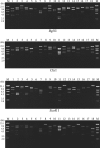Genetic diversity of Acanthamoeba isolated from ocean sediments
- PMID: 16809959
- PMCID: PMC2532631
- DOI: 10.3347/kjp.2006.44.2.117
Genetic diversity of Acanthamoeba isolated from ocean sediments
Abstract
Genetic diversity of 18 Acanthamoeba isolates from ocean sediments was evaluated by comparing mitochondrial (mt) DNA RFLP, 18S rDNA sequences and by examining their cytopathic effects on human corneal epithelial cells versus reference strains. All isolates belonged to morphologic group II. Total of 16 restriction phenotypes of mtDNA from 18 isolates demonstrated the genetic diversity of Acanthamoeba in ocean sediments. Phylogenetic analysis using 18s rDNA sequences revealed that the 18 isolates were distinct from morphological groups I and III. Fifteen isolates showed close relatedness with 17 clinical isolates and A. castellanii Castellani and formed a lineage equivalent to T4 genotype of Byers group. Two reference strains from ocean sediment, A. hatchetti BH-2 and A. griffini S-7 clustered unequivocally with these 15 isolates. Diversity among isolates was also evident from their cytopathic effects on human corneal cells. This is the first time describing Acanthamoeba diversity in ocean sediments in Korea.
Figures



References
-
- Altschul SF, Gish W, Miller W, Myers EW, Lipman DJ. Basic local alignment search tool. J Mol Biol. 1990;215:403–410. - PubMed
-
- Booton GC, Rogerson A, Bonilla TD, Seal DV, Kelly DJ, Beattie TK, Tomlinson A, Lares-Villa F, Fuerst PA, Byers TJ. Molecular and physiological evaluation of subtropical environmental isolates of Acanthamoeba spp, causal agent of Acanthamoeba keratitis. J Eukaryot Microbiol. 2004;51:192–200. - PubMed
-
- Chung DI, Kong HH, Yu HS, Oh YM, Yee ST, Lim YJ. Biochemical and molecular characterization of a strain KA/S2 of Acanthamoeba castellanii isolated from Korean soil. Korean J Parasitol. 1996;34:79–85. - PubMed
-
- Chung DI, Yu HS, Hwang MY, Kim TH, Kim TO, Yun HC, Kong HH. Subgenus classification of Acanthamoeba by riboprinting. Korean J Parasitol. 1998;36:69–80. - PubMed
-
- Clark CG. Protocols in protozoology. vol. 1. Lawrence, Kans: Lee & Soldo; 1992. pp. D-4.1–D-4.4.
MeSH terms
Substances
LinkOut - more resources
Full Text Sources

